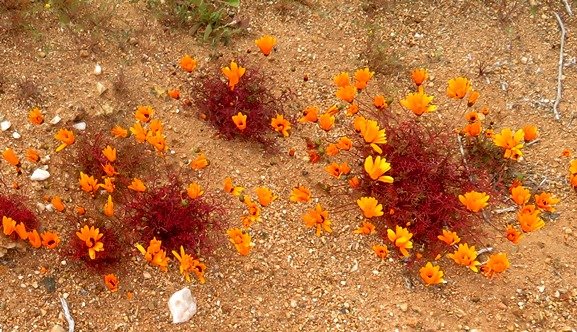Ursinia calenduliflora

Author: Ivan Lätti
Photographer: Thabo Maphisa
Ursinia calenduliflora is establishing vivid colour upon its sandy surroundings here. This is delivered as much by the purple leaves conveying stress, as from the orange flowers heralding achievement.
The colour of hardship might catch a few more pollinator eyes over and above those that the flowers will attract. Any augmentation of seed quantities spells more success, which is the purpose of plant life and the positive in this plant’s suffering. And all this is manifested in the real world via evolution without the benefit of a brain!
Annual spring flower tourists visiting the region may miss nature’s adversity message implicit in the Namaqualand sandy flats and rocky slopes. There is the inevitable hard part coming later, every year. All the local species have evolved their unique ways of coping with their seasonal challenge.
One of these coping mechanisms is simply to not be around in live plant form during times when conditions are too terrible to face. This is analogous to hibernating mammals that periodically enter a physiological state of torpor during which body temperature drops and heart and respiration rates slow drastically. All to return to normal in the right season. Hibernation is often aligned to seasonal conditions of uncomfortable temperatures and poor food availability, until normal functioning can be resumed for reproductive cycles to run their course.
Namaqualand annuals systematically duck parts of the long, hot and dry seasons by preserving their species temporarily in dry seed form. Having skipped the hardest six months or so, they awaken as new seedlings, a new generation triggered by winter rain and comfortable temperatures. Then follows a quick, productive (i.e. reproductive) life, lasting for a few months during which the plant’s full cycle repeats, as for the plants of generations before it.
A bit like a chicken being an egg’s way of producing another egg, a viewpoint likely to be espoused by consumers of Ursinia seeds, if they ever could think that far (Manning, 2009; Le Roux, et al, 2005; iNaturalist; Wikipedia; http://pza.sanbi.org).

